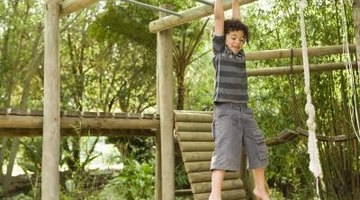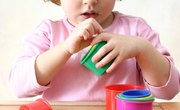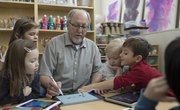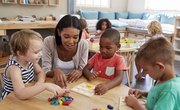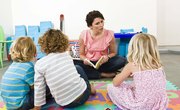Children learn best when they are actively engaged in activities that reinforce skills. Young children especially need opportunities to move their bodies while learning, and are not capable of sitting still for hours at a time just listening to a lecture. One way to get your class moving their bodies as well as reinforce important skills is to create obstacle courses for children that involve proving their mastery of certain skills before being able to move to the next station.
Listening Skills
The most important aspect of completing an obstacle course is being able to listen to and follow simple directions. When creating obstacle courses for children's learning, begin with a very simple course designed to enhance and reinforce listening skills. When working with very young children, be sure to give only two-step directions for children to remember. As children grow, it will be possible to add more steps to the directions. For example, an obstacle course activity for five-year-old children may consist of running 100 feet to a bucket, dropping a tennis ball into it, and running back to the teacher before moving to the next activity. An eight-year-old child will be able to run to the bucket, drop a tennis ball into it, run around the bucket three times, do a cartwheel and then return to the teacher. Be sure children know the directions for each station before beginning, and deduct points or add time to scores for teams that are unable to follow directions if you are conducting the obstacle course as a race.
Gross Motor Skills
When people think of obstacle courses, it often brings to mind a rigorous military style physical challenge. While you don't have to include military boot camp style challenges in your obstacle course, do design it to exercise children's large muscles. Take into consideration each child's gross motor abilities when designing obstacle courses for children's learning. For example, a course for six- to seven-year-old children could include running 25 yards, walking across a low balance beam, kicking a playground ball, skipping 25 yards, jumping jacks and somersaulting across the finish line. An obstacle course for ten- and eleven-year-old children can include a longer run or more challenging balancing activities.
Fine Motor Skills
Obstacle courses for children's learning do not have to be all about running and exercising. There are plenty of fine motor activities that can be included in a simpler obstacle course. Fine motor obstacle courses are a great classroom idea for a rainy day when recess is not an option. An example of a fine motor obstacle course for seven- to eight-year-old children is to stack an assortment of ten wooden blocks, tie two pairs of shoes, string 15 beads, copy three sentences on a chalkboard or dry-erase board and picking up 10 cotton balls with tweezers and dropping them in a bucket. You can modify the activities for older or younger students.
Cognitive Skills
A cognitive obstacle course is a good choice for older students. Use a cognitive obstacle course after completing an area of study as a way to review everything the children have learned. For example, use this obstacle course with older elementary school children after completing a unit on the U.S. presidents. Have children match five to ten U.S. presidents with the dates he was in office, complete a question and answer worksheet stating the birthplace of ten U.S. presidents, match the president with the name of his spouse, and create two or three puzzles using presidential portraits. Once the puzzle is put together, the student must correctly identify the president before successfully completing the course.
Related Articles
References
- "500 Five Minute Games"; Jackie Silberg; 1995
Writer Bio
Kara Bietz has been writing professionally since 1999. Her professional observation work has appeared in the early childhood education textbook "The Art of Awareness" by Margie Carter and Deb Curtis. Bietz has worked in the field of early childhood education for more than 16 years. She holds an Associate of Applied Science in child development from Mesa College.

